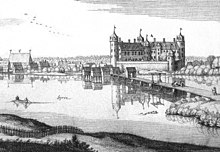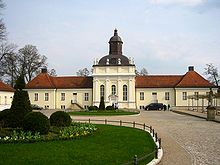Köpenick Castle

The Schloss Koepenick is located in the historic center of Berlin hamlet Koepenick .
geography
The castle is located opposite the Köpenick city center with the Köpenick town hall on an island in the Dahme , not far from its confluence with the Spree . The island is connected to the mainland by a bridge over the moat. In the immediate vicinity is the Long Bridge , which crosses the Dahme and connects the old town of Köpenick as well as the Castle Island and the Castle with the newer districts to the west and north-west and the center of Berlin .
building
Prehistory and early history
The later castle island Köpenick was already settled in prehistoric times and is one of the earliest settlement areas in today's Berlin urban area , along with Spandau and the twin cities of Alt-Berlin / Cölln . Slavic ramparts were found here later , a Slavic castle was built in the 8th or 9th century. The Slav prince Jaxa von Köpenick ruled here in the 12th century. Several subsequent buildings followed, including a late medieval fort castle . Around 1245 the Ascanians conquered the castle island. The Slavs were resettled on the eastern bank of the Dahme, where they settled in a Kietz .
Renaissance hunting lodge

After the old buildings were demolished (probably around 1550), Elector Joachim II of Brandenburg ordered the construction of a hunting lodge in the Renaissance style in 1558 . It was equipped with two residential wings and two defensive walls. The builder Wilhelm Zacharias was responsible . Little has been said about this building; The size, arrangement and defensive strength, however, are likely to have been a little more powerful than the preserved Grunewald hunting lodge . Joachim died nearby in 1571 during a hunting expedition.
Baroque castle
The palace was expanded for Prince Elector Friedrich (later Elector Friedrich III of Brandenburg, then King Friedrich I in Prussia) from 1677 onwards. As an architect here was Rutger Langer field , a native Dutchman from Nijmegen , responsible. The northern pavilion was built in 1679–1682. The architect Johann Arnold Nering followed van Langervelt in building the palace in 1684 and had the economic wing with the reformed palace church (consecrated on January 6, 1685) and the courtyard gate (1682) built. Friedrich later lived in the castle with his wife Elisabeth Henriette von Hessen-Kassel , who is said to have initiated the construction of the church.
In the following years the construction of a three-wing complex was planned. A central wing was added to the northern pavilion and a new southern pavilion was created. This gave the castle its present form and was expanded until 1690.
In the years 1693–1695 work took place on the corps de logis , but the plan for a three-wing building was soon discarded.
The showpiece of the palace is the coat of arms hall on the second floor.
The gallery was changed in 1750 by walling up the arcades .
The two gatehouses were built between 1804 and 1806. In 1884, the paneling and a stove in a state room from the Swiss Haldenstein Castle were sold to the German Industrial Museum (later the Museum of Applied Arts) in Berlin. It was later installed in Köpenick Castle.
Todays use
Wilhelm Unverzagt initiated an archaeological investigation in 1938. Among other things, a larger part of the foundations of the castle was exposed. In 1963 the palace became the location of the East Berlin Museum of Applied Arts and was therefore open to the public for the first time.
Extensive restoration work began in 1994. Here old parts of the building were also discovered. After the renovation was completed, the palace was reopened on May 27, 2004 and now houses the second building of the Museum of Applied Arts of the Staatliche Museen zu Berlin next to its headquarters at the Kulturforum near Potsdamer Platz . The permanent exhibition with the title “Room art from the Renaissance , Baroque and Rococo ” shows a cross-section of interior design from the 16th to 18th centuries in 21 rooms on three floors.
Adjacent to the church, the eastern building now houses a restaurant.
Castle Park
Baroque garden
Around 1690 a small baroque garden was laid out south of the castle .
In the summer of 1712, an aloe ( Agave americana) with a height of almost ten meters caused a sensation . It had 44 branches and 7,277 flowers. The agave went down in the history of the palace park as a "miracle aloe" and was admired by the Russian Tsar Peter the Great as well as by other important visitors to the park. There are hardly any pictures or plans of the park from this period.
Landscape park
The garden, which was previously in good condition, became increasingly overgrown after the death of Duchess Henriette Marie von Württemberg-Teck (1782). From 1804, therefore, the baroque palace garden was redesigned into a landscape park under Friedrich Wilhelm Carl von Schmettau . After Schmettau's death, the park returned to the Krone and overgrown again.
Another change to the park took place in 1963/1964. Here, however, historical designs were not taken up, so that from now on the palace park conveyed an ahistorical image. At least the woody vegetation in the Köpenick Castle Park still indicates the influence of the lowlands.
There are several sculptures and memorial plaques in the castle park. Its main path runs not far from the water, which it offers a good view. In the middle of the park there is a larger open area that allows an unobstructed view of the castle. The castle courtyard is also used for events and concerts, especially in the summer months.
Historical events
In addition to the usual use as a residential building and hunting lodge, the following were of particular importance:
- In 1631 King Gustav Adolf of Sweden seized the previous building as his headquarters and urged his brother-in-law, the fickle Elector Georg Wilhelm , to take part in the Thirty Years' War on his side . A personal encounter near Koepenick was fruitless.
- 1681–1684 residence of Prince Elector Friedrich . His coat of arms hall caused a scandal in the Brandenburg state in 1682 : the comprehensive series of coats of arms made clear the elector's claim to the undivided inheritance of all parts of the country, contrary to the will of his father, the " Great Elector ".
- On October 25, 1730 Wappensaal convened the court-martial against Crown Prince Frederick and his friend Hans Hermann von Katte , where desertion was accused. In the case of the Crown Prince, it declared itself incompetent, while in the case of Katte it recognized that it was under lifelong arrest. King Friedrich Wilhelm I rejected the judgment that had been passed again in a second hearing on October 30th and imposed the death penalty on Katte by cabinet order on November 1st, 1730.
- 1749–1782 the widow's seat of Princess Henriette Marie .
- 1824–1846 Use of the island as a traindepot for the Prussian army: sheds and sheds for ammunition wagons were set up in the palace gardens (the island location made it easier to protect against theft).
- 1830–1848 ( restoration period ) The building was used as a prison for so-called “ demagogues ”, ie political prisoners.
- 1851–1926 teacher training college (previously in Potsdam ).
literature
- Theodor Fontane : Walks through the Mark Brandenburg , Volume 4: "Spreeland" - On the Spree .
- Josef Batzhuber: Garden of the Köpenick Castle Island, Treptow-Köpenick district . In: Bund Heimat und Umwelt in Deutschland (Ed.): White paper on historical gardens and parks in the new federal states . 2nd revised edition. Bonn 2005, ISBN 3-925374-69-8 , pp. 34-36 .
- Folkwin Wendland: Berlin's gardens and parks from the founding of the city to the end of the nineteenth century . In: Classic Berlin . Propylaea, Berlin 1979, ISBN 3-549-06645-7 , pp. 338-341 .
- Walther Friebe: Köpenick Castle . In: Journal of Construction . Volume 57 (1907), col. 505-540, plates 60-65. Digitized in the holdings of the Central and State Library Berlin .
- Raimund Hertzsch: Koepenick Castle . In: The historical place 90 . Kai Homilius, Berlin 1997, ISBN 3-89706-089-2 .
- Lothar Lambacher (ed.): Köpenick Castle. Archeology, building history, use . Schnell & Steiner, Regensburg 2005, ISBN 3-7954-1630-2 .
- Günter Schade: Köpenick Castle. A journey through the history of the Köpenick Castle Island . 4th improved edition. State Museums in Berlin, Museum of Applied Arts, Berlin 1975.
- National Museums in Berlin (ed.): Köpenick Castle. Kunstgewerbemuseum: European arts and crafts from ten centuries . State museums, Kunstgewerbemuseum, Berlin 1976.
Web links
- Gunnar Nath: Ground monument maintenance at Köpenick Castle . Preservation of monuments on site. Senate Department for Urban Development Berlin.
- Entries in the Berlin State Monument List: Castle with castle church andCastle Park
- State Museums of Berlin: Museum of Applied Arts . In addition to its headquarters at the Kulturforum Potsdamer Platz, the Kunstgewerbemuseum opened Köpenick Castle as a second location in May 2004.
Individual evidence
- ^ Georg Dehio : Handbook of German Art Monuments, Berlin. Deutscher Kunstverlag, 2006, ISBN 3-422-03111-1 , pp. 540-541
- ↑ Stefanie Leibetseder: Refurbished and internationally. The Köpenick Castle Church within the church architecture of the late 17th century . In: Lothar Lambacher and Mathis Leibetseder (eds.): KREUZWEGE. THE HOHENZOLLERN AND THE CONFESSIONS 1517-1540 [exh. Cat.] Berlin 2017, p. 140-149 .
- ↑ Johannes Kunisch : Frederick the Great. The king and his time. CH Beck, Munich 2004, ISBN 3-406-52209-2 , pp. 36-38.
Coordinates: 52 ° 26 ′ 38 ″ N , 13 ° 34 ′ 22 ″ E






